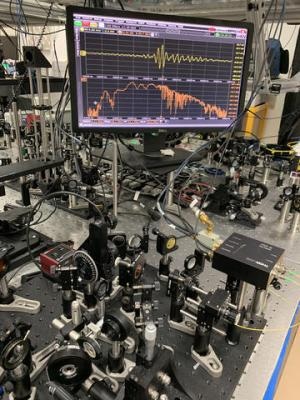Jun 10 2019
Scientists at the National Institute of Standards and Technology (NIST) and collaborators have shown a compact frequency-comb apparatus that quickly measures the whole infrared band of light to identify chemical, biological, and physical properties of matter. Compared to visible light, infrared light travels in longer waves and is most familiar as the radiation related to heat.
 NIST’s tabletop frequency comb apparatus (foreground) can quickly identify molecules based on their absorption of infrared light. The yellow squiggle at the top of the screen is the electric field of mid-infrared laser light that has passed through air in the lab. The orange pattern at the bottom of the screen shows the corresponding spectrum of the light, with the downward spikes indicating the exact colors absorbed by water detected in the air. (Image credit: NIST)
NIST’s tabletop frequency comb apparatus (foreground) can quickly identify molecules based on their absorption of infrared light. The yellow squiggle at the top of the screen is the electric field of mid-infrared laser light that has passed through air in the lab. The orange pattern at the bottom of the screen shows the corresponding spectrum of the light, with the downward spikes indicating the exact colors absorbed by water detected in the air. (Image credit: NIST)
The NIST system, which requires just a few square feet of table space, has promising applications such as identification of chemicals used in manufacturing, disease diagnosis, and biomass energy harvesting. The research is illustrated in Science Advances.
Optical frequency combs measure precise frequencies, or colors, of light. Different comb designs have allowed the creation of next-generation atomic clocks and exhibit potential for environmental applications such as detecting methane leaks. Biological applications have been sluggish to develop, partly because it has been hard to straightaway produce and measure the appropriate infrared light.
To promote biological applications, the NIST team employed the new apparatus to detect “fingerprints” of NIST’s monoclonal antibody reference material, a protein composed of over 20,000 atoms that is used by the biopharmaceutical sector to guarantee treatment quality.
“For the first time our frequency combs have simultaneous coverage across the entire infrared molecular fingerprint region,” project leader Scott Diddams said. “Other key advantages are speed, resolution and dynamic range in acquiring data.”
Mid-infrared light is a particularly beneficial research probe because molecules typically rotate and vibrate at these frequencies. However, thus far, it has been hard to probe this region because of a lack of tunable or broadband light sources and efficient detectors like those available for visible and near-infrared light, the region of the infrared spectrum adjoining the visible light.
The new NIST apparatus overcomes these issues. Basic fiber lasers produce light spanning the whole range used to detect molecules—that is, mid-infrared to far-infrared wavelengths of 3-27 mm (frequencies of approximately 10-100 terahertz). The amounts of light absorbed at particular frequencies deliver a unique signature of a molecule. The new system is unprecedented in detecting the electric fields of the absorbed light using photodiodes (light detectors) functioning in the near-infrared range.
A unique feature is that we detect signals in real time by rapidly sampling the infrared electric field with a near-infrared laser. This has two advantages: It shifts the detection from the infrared to the near-infrared where we can use inexpensive telecommunications photodiodes, and we no longer suffer from the limitations of infrared detectors, which require cryogenic (liquid nitrogen) cooling.
Scott Diddams, Project Leader, NIST
The scientists noticed signature vibrations of three bands of amides (chemical groups comprising of oxygen, nitrogen, carbon, and hydrogen) in the monoclonal antibody reference material. Amide bands in proteins are used to establish the folding, unfolding, and aggregating mechanisms. Particular features of the detected bands showed that the protein has a sheet structure, thus backing up former studies. Sheets link chemical groups in a flat setup.
Besides biological applications, the new apparatus might be used to sense interactions between infrared light and condensed matter for quantum computing methods that store data in molecular rotations or vibrations. Furthermore, when integrated with novel imaging methods, the tabletop system could acquire nanometer-scale images of samples that presently necessitate the use of a much larger synchrotron facility.
The new paper’s co-authors include scientists from the University of Campinas, in Brazil, and the Institute of Photonic Sciences, in Spain. The Defense Advanced Research Projects Agency, the National Research Council and the Air Force Office of Scientific Research funded this research.